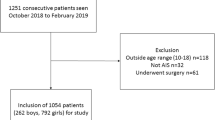Abstract
Purpose
PT and PI-LL sometimes offer limited utility in daily practice when evaluating QOL, especially in outpatient clinics with limited time and equipment facility. This study proposes a novel spino-pelvic parameter, lumbo-femoral angle (LFA). The purpose of this study is to analyze the correlation between LFA and HRQOL in adult scoliosis patients.
Methods
A cohort of 100 asymptomatic adult volunteers and 50 patients with adult scoliosis were prospectively recruited. The following sagittal parameters including thoracic kyphosis (TK), LL, LFA, PI, PT and sacral slope (SS) were measured on the long-cassette standing upright lateral radiographs. Health-related QOL (HRQOL) measures included the VAS, ODI and SF-36 instruments for patients with adult scoliosis.
Results
LFA, the novel regional lumbo-sacral parameter, averaged 0.68° ± 4.5° in normal adults with the 95 % CI value of −7° to 7°. Similar intra- and inter-observer intraclass correlations and less measurement time were observed in LFA compared to PI-LL indicating that it is easy to quantitatively evaluate the regional alignment directly from X-ray films. Although LFA in patients with adult scoliosis was found to be significantly larger (11.8° ± 8.7° vs. 0.68° ± 4.5°, p < 0.001), it showed strong correlations with the PT and PI-LL in both groups (p < 0.001). Additionally, a summary of correlations between LFA and QOL measurements was identified (p < 0.05).
Conclusion
LFA could be considered a novel, user-friendly sagittal parameter, correlated with previously established sagittal spino-pelvic parameters and HRQOL measurements. LFA showed high inter- and intra-observer reliability, faster measurement times and could be easily identified and read. Mean LFA in asymptomatic adult patients was nearly 0° with 95 % CI value of −7° to 7°, and significantly increased in adult scoliosis patients.



Similar content being viewed by others
References
Barrey C, Roussouly P, Perrin G et al (2011) Sagittal balance disorders in severe degenerative spine. Can we identify the compensatory mechanisms? Eur Spine J 20(suppl 5):626–633
Lafage V, Schwab F, Vira S et al (2011) Spino-pelvic parameters after surgery can be predicted: a preliminary formula and validation of standing alignment. Spine (Phila Pa 1976) 36:1037–1045
Lafage V, Schwab F, Patel A et al (2009) Pelvic tilt and truncal inclination: two key radiographic parameters in the setting of adults with spinal deformity. Spine (Phila Pa 1976) 34:E599–E606
Schwab FJ, Patel A, Shaffrey CI et al (2012) Sagittal realignment failures following pedicle subtraction osteotomy surgery: are we doing enough? J Neurosurg Spine 16:539–546
Mac-Thiong JM, Transfeldt EE, Mehbod AA et al (2009) Can c7 plumbline and gravity line predict health related quality of life in adult scoliosis? Spine (Phila Pa 1976) 34:E519–E527
Schwab F, Lafage V, Shaffrey CI et al (2012) 138 The Schwab-SRS adult spinal deformity classification: assessment and clinical correlations based on a prospective operative and non-operative cohort. Neurosurgery 71:E556
Schwab FJ, Blondel B, Bess S et al (2013) Radiographical spinopelvic parameters and disability in the setting of adult spinal deformity: a prospective multicenter analysis. Spine (Phila Pa 1976) 38:E803–E812
Schwab F, Ungar B, Blondel B et al (2012) Scoliosis Research Society-Schwab adult spinal deformity classification: a validation study. Spine (Phila Pa 1976) 37:1077–1082
Hongda B, Zhen L, Feng Z et al (2014) Is the Sacro-Femoral-Pubic Angle Predictive for Pelvic Tilt in Adolescent Idiopathic Scoliosis Patients? J Spinal Disord Tech 27:E176
Roussouly P, Pinheiro-Franco JL (2011) Biomechanical analysis of the spino-pelvic organization and adaptation in pathology. Eur Spine J 20(Suppl 5):609–618
Mac-Thiong JM, Roussouly P, Berthonnaud E et al (2011) Age- and sex-related variations in sagittal sacropelvic morphology and balance in asymptomatic adults. Eur Spine J 20(suppl 5):572–577
Dupont WD, Plummer WD Jr (1990) Power and sample size calculations. A review and computer program. Control Clin Trials 11:116–128
Faul F, Erdfelder E, Buchner A et al (2009) Statistical power analyses using G*Power 3.1: tests for correlation and regression analyses. Behav Res Methods 41:1149–1160
White JS (1970) Tables of Normal Percentile Points. J Am Stat Assoc 330:635–638
Legaye J, Duval-Beaupere G, Hecquet J et al (1998) Pelvic incidence: a fundamental pelvic parameter for three-dimensional regulation of spinal sagittal curves. Eur Spine J 7:99–103
Roussouly P, Pinheiro-Franco JL (2011) Sagittal parameters of the spine: biomechanical approach. Eur Spine J 20(suppl 5):578–585
Mac-Thiong JM, Labelle H, Berthonnaud E et al (2007) Sagittal spinopelvic balance in normal children and adolescents. Eur Spine J 16:227–234
Zhu Z, Xu L, Zhu F, et al. (2013) Sagittal alignment of spine and pelvis in asymptomatic adults: norms in Chinese population. Spine (Phila Pa 1976)
Yong Q, Zhen L, Zezhang Z et al (2012) Comparison of sagittal spinopelvic alignment in Chinese adolescents with and without idiopathic thoracic scoliosis. Spine (Phila Pa 1976) 37:E714–E720
Acknowledgments
This work was supported by National Key Clinical Department Project and Talents Programme of Jiangsu (Grant No. WSW-005). The authors thank Dr. Anthony Boniello for the contribution to this paper.
Conflict of interest
The manuscript submitted does not contain information about medical device(s)/drug(s). No benefits in any form have been or will be received from a commercial party related directly or indirectly to the subject of this manuscript.
Author information
Authors and Affiliations
Corresponding author
Rights and permissions
About this article
Cite this article
Zhu, F., Bao, H., He, S. et al. Lumbo-femoral angle: a novel sagittal parameter related to quality of life in patients with adult scoliosis. Eur Spine J 24, 1244–1250 (2015). https://doi.org/10.1007/s00586-014-3614-2
Received:
Revised:
Accepted:
Published:
Issue Date:
DOI: https://doi.org/10.1007/s00586-014-3614-2




